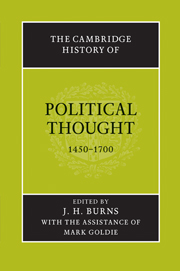Book contents
- Frontmatter
- Introduction
- I Renaissance and Counter-Renaissance
- 1 Humanism and political theory
- 2 Italian political thought, 1450–1530
- 3 Law
- 4 Transalpine humanism
- 5 Scholasticism: survival and revival
- II Religion, civil government, and the debate on constitutions
- III Absolutism and Revolution in the Seventeenth Century
- IV The end of Aristotelianism
- V Natural law and utility
- Conclusion
- Biographies
- Bibliography
- Index of names of persons
- Index of subjects
- References
2 - Italian political thought, 1450–1530
from I - Renaissance and Counter-Renaissance
Published online by Cambridge University Press: 28 March 2008
- Frontmatter
- Introduction
- I Renaissance and Counter-Renaissance
- 1 Humanism and political theory
- 2 Italian political thought, 1450–1530
- 3 Law
- 4 Transalpine humanism
- 5 Scholasticism: survival and revival
- II Religion, civil government, and the debate on constitutions
- III Absolutism and Revolution in the Seventeenth Century
- IV The end of Aristotelianism
- V Natural law and utility
- Conclusion
- Biographies
- Bibliography
- Index of names of persons
- Index of subjects
- References
Summary
The middle of the fifteenth century was a turning point in the relations between the Italian states, and the relative stability which Italy enjoyed until the Neapolitan expedition of Charles VIII in 1494 forms part of the background to the history of its political thought during that period. The peace of Lodi had put an end, in 1454, to a succession of wars which had begun in the 1420s. It had been followed by the conclusion of an Italian league, aimed at safeguarding the integrity of the Italian states as well as peace among them; in fact, wars were chiefly prevented or contained by triple and dual alliances between the five greater powers which were its members, Milan, Venice, Florence, the papacy, and Naples.
To the relative stability and equilibrium in inter-state relations, threatened primarily by the expansionist policies of Venice and the papacy, there corresponded a similar stability in the internal conditions of the Italian states, although it too could be temporarily threatened. Domestic crises occurred in Milan in 1476 with the assassination of Duke Galeazzo Maria Sforza; in Florence in 1478 with the Pazzi conspiracy, but these were of short duration; far more serious and lasting was the revolt of the Neapolitan barons against Ferrante of Aragon in 1485. The lesser princes, such as the Malatesta at Rimini and the Este at Ferrara, were more vulnerable; a judicious policy of placing themselves under the protection of one or more of the greater powers, as well as serving them as condottieri, could help them to achieve security and dynastic survival.
- Type
- Chapter
- Information
- The Cambridge History of Political Thought 1450–1700 , pp. 30 - 65Publisher: Cambridge University PressPrint publication year: 1991
References
- 15
- Cited by

